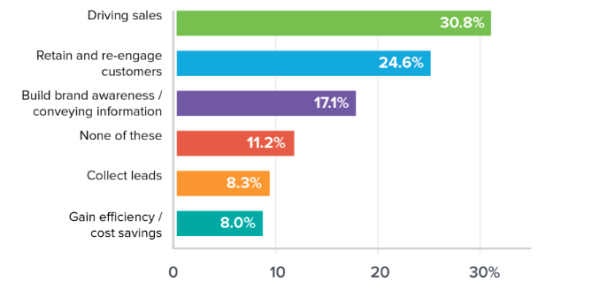If we asked you what your business goal is for the next year, you’d probably say “get more business” or something along those lines.
But what if we asked you to dig deeper? What if we asked you what “get more business” means for you?
If you can’t answer, you’re not alone.
In fact, many new and small businesses don’t have a clear goal in mind. They often think they’re not big enough to set lofty goals and are simply striving to keep their heads above water.

In the 2019 Small Business Report, “driving sales” was the biggest goal.
While this is all well and good, it can often leave you lacking focus if you don’t know where you want to go.
It’s kind of like setting out for a location on the other side of town and not knowing the route to get there.
The thing is, successful businesses all have one thing in common regardless of how big or small they are. They all have a clear set of goals with specific objectives.
Basically, they know what they want to achieve and they’ve mapped out a plan to get them there. Without first year business goals, you risk spending your pivotal first year flailing around in the dark.
Setting goals can be tricky, though, which is why many small business owners turn to the SMART goal setting method.
This is an acronym for Specific, Measureable, Attainable, Relevant, and Time-Based goals, and is one of the most effective methods that high-flying businesses use to keep pushing forward.
Introducing the SMART way of goal setting
Specific
First and foremost, your SMART goals have to be clear and concise. None of this wishy washy “I want to be successful” business.
The best goals are well-defined and have a very distinct focus. Rather than “get more business,” you might decide that you want to “sign 2 new million-dollar corporate clients in the property rental market,” for example.
When you have a goal that’s this specific, it’s easy to see when you’ve reached it and what steps might be involved in getting there.
At this stage, you should be asking yourself questions like:
- What exactly do I want to accomplish?
- What would success look like in numbers for me?
- Why is this goal important?
Remember, you can set more than 1 SMART goal at any given time, which gives you leeway to create a series of highly-specific goals.
Measureable
SMART goals always have to be quantifiable in some way so that you can track them. This usually means you need a number or a percentage involved, like “sign 10 new clients each month” or “increase my website pageviews by 20%.”
If you don’t put a finish line on your goal, how will you know when you’ve achieved it?
It can really help you to see the progress of your success if you have a physical reminder of where you’re at with your goal each month. For example, you might have a white board in your office that tallies how many new clients you’ve signed every week.
At this point, you should be asking yourself questions like:
- How much do I want to increase my sales/website traffic/social media following by?
- How many clients/sales/inquiries do I want to get each month?
- How will I know when it is accomplished?
Attainable
All goals should be challenging. If you can easily smash them, then what’s the point?
However, they should also be achievable otherwise you’re going to be disappointed over and over again.
Plenty of small businesses are guilty of setting goals way out of their reach, which only leads to negative feelings of failure.
Think about it: you can’t build a billion dollar business overnight, but you can take yearly steps to get there.
It’s important that you aim big, of course, but you also need to keep your head firmly out of the clouds.
To help, ask yourself questions like:
- How can I accomplish this goal?
- How realistic is this goal?
- What financial factors do I need to bear in mind?
Relevant
There’s no point having goals that are irrelevant for your business just because you read somewhere that someone else had the same goal.
SMART goals should add value to your business and align with other goals you have to create a unique set of objectives.
At this point, you should be thinking about the current business climate in your industry. For example, if there’s a recession looming or a number of big competitors have emerged in your market, you need to bear that in mind.
Ask yourself questions like:
- Does this goal seem worthwhile?
- Is it the right time for this goal?
- Does this goal match my other efforts?
Time-Based
Just like SMART goals should have a number or percentage attached to them, they should also have a specific time frame in mind. This helps you stay motivated and able to measure your success when you hit that time milestone.
Even if your goal is to increase revenue by 30% or sign 10 new clients, you need to have a time frame in mind.
Do you want to increase revenue by 30% in a month? A year? 5 years?
See how important having a time frame is?
At this stage, ask yourself questions like:
- When can I complete this by realistically?
- What can I do 6 months from now?
- What can I do today?
Best smart goal examples for small businesses' first year
Now you know what goes into a SMART goal, let’s turn some regular goals into SMART goals to fuel your inspiration over the coming year.
- “I want to grow my business”
Turn this into: I will sign 25 new clients in the next 6 months by offering special discounts to new leads. This will help grow my business and increase my revenue.
- “I want to increase sales”
Turn this into: In order to increase my sales to $200,000 a year, I will hire 1 experienced salesperson to grow sales by 5% in the first quarter, 10% in the second, 15% in the third, and 20% in the fourth.
- “I want to improve product quality”
Turn this into: I want to reduce defects to less than 3% of shipped goods. To do this, I will implement a new test and inspection feature to reduce the shipping of defective products by 10% per quarter.
- “I want to save money”
Turn this into: I want to raise $20,000 of business capital so I can quit my day job by the end of the year.
Start setting SMART goals today
Setting goals is an exciting activity for new business owners.
The world is your oyster, and you can literally dream up plenty of amazing ways your business can succeed over the coming months and years.
But, in order to see real success, you have to set the right goals.
This is where the SMART goal setting method really comes into play. By creating Specific, Measureable, Attainable, Relevant, and Time-Based goals, you’re able to measure your progress and track exactly where you need to be and by when.
About the author:

Scott Miraglia is the CEO of Elevation Marketing. He is a balanced risk-taker with nearly 3 decades of experience starting and growing advertising and marketing agencies. His business acumen is matched with a drive to build creative teams that thrive in open, collaborative work environments. Scott seeks out the best creative individuals, not only to provide quality service to clients, but to also help shape the future direction of Elevation Marketing. He remains dedicated to helping his talented teams develop unique and effective integrated marketing programs that help employees realize their full potential while serving up impressive business wins for clients.


